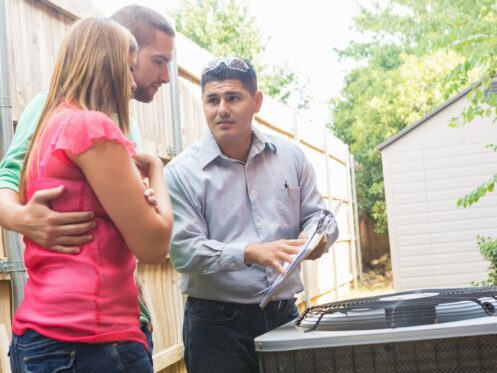If your AC isn’t blowing cold air, you might have a leak. This can be extremely inconvenient during the summer in Louisville, KY. The summer temperatures here often stay above 90 degrees Fahrenheit during the day. Finding the exact cause of the leak is paramount to restoring your system’s performance.
Common Signs Your AC Has a Leak
Understanding the common warning signs can help you catch AC leaks early. This is crucial to avoiding expensive cooling repairs like compressor failure and water damage.
- Weak airflow from the vents
- Warm air blowing instead of cool
- Ice forming on the evaporator coil
- Unusual hissing or bubbling sounds
- Water pooling around the unit
- Higher than normal energy bills
- AC takes longer to cool rooms
Why AC Leaks Happen in the First Place
There are many types of AC leaks. Some are easy to fix, while others require expert repair. Refrigerant leaks are probably what you think about when you hear the term “AC leak.” The top causes of refrigerant leaks include corrosion, loose connections, and damaged refrigerant lines. These lead to the AC not blowing cold air and can be dangerous to your health.
Water leaks caused by a clogged condensate drain line are another type of AC leak. The condensate drain line is responsible for draining condensation from the evaporator coil. When it clogs with algae or debris, the moisture will back up, possibly causing water damage to walls, floors and ceilings. A damaged drain pan can lead to the same problem.
Neglecting annual AC maintenance will also cause leak problems. Dirty parts will force the air conditioner to work harder, increasing the risk of leaks from cracked coils and loose connections. This also uses more energy, which will lead to summer utility bills skyrocketing.
How to Check for an AC Leak
You can take some basic steps to identify simple issues if you suspect your AC has a leak. Getting an expert’s opinion will ensure you don’t miss a hidden problem.
Inspecting the Evaporator Coil
The evaporator coil sits inside the indoor unit. It has the job of pulling heat out of the air and sending it outside the home. But it’s also a common source of refrigerant leaks. To check this part, you’ll need to open the access panel on the indoor part of the AC. If you see ice buildup or frost on the coil, you might have a leak. An oily residue around the coil is a definite sign that the refrigerant is escaping. Never try to clean or fix the coil yourself. A technician will have to repair the damage and recharge the system.
Examining the Condensate Drain Line
As your AC cools your home, it also pulls moisture out of the air and drains it through the condensate drain line. But over time, this line can clog with algae, mold and dirt. Any type of blockage will stop the water from draining, and the only place it will have to go is back into your home. You can check the line for a clog by checking the PVC pipe near the indoor unit. If the AC is on, you should see water dripping from the pipe. If you don’t see any dripping water or notice water pooling near the unit, there’s probably a clog. You might be able to use a wet/dry vacuum to clear the blockage and keep water flowing properly.
Looking for Damage Around the Drain Pan
The drain pan is the part of the AC that sits below the evaporator coil. It has the job of catching water as it exits the drain line. As time passes, these pans can rust and crack, especially those made of metal. To see whether yours has damage, just take a flashlight and look inside the bottom of the indoor unit. If you see any standing water, rust or cracks in the drain pan, you should take immediate action. You may need to replace the pan or call a technician to inspect and repair the issue.
Checking Ductwork for Air Leaks
Not all AC leaks involve water or refrigerant. Some are air leaks that occur in the ductwork. This is why it’s so important to have a professional install your ductwork and cooling setup. They can carefully inspect everything to make sure there aren’t any gaps or cracks. You don’t want conditioned air escaping through holes or uneven seams. This will increase cooling costs, hurt indoor comfort and may even damage the AC. The best way to check for duct leaks is to look for visible holes and loose connections. You can also listen for a hissing sound since the escaping air will make this noise. If you find any small gaps, you can seal them with foil tape or mastic, but not duct tape. Large gaps and sections that have extensive damage will need professional repair.
Benefits of Professional Leak Diagnosis vs DIY Approach
Doing your own inspection for leaks is helpful, but you might not catch everything. Professionals have advanced tools like leak detectors, UV dye kits and pressure gauges they can use to identify the exact location and source of all leaks. Their knowledge and understanding of cooling systems ensures they accurately diagnose the problem. From electrical issues and worn-out parts to improper installation, professional technicians will find the problem and fix it correctly. They have the proper training and certification to handle the refrigerant safely, too.
Preventive Maintenance to Avoid Future Leaks
Fortunately, there are lots of ways to prevent future AC leaks. The most important thing you can do is schedule annual AC tune-ups. A technician will inspect the system using specialized tools and gauges to find leaks caused by wear, corrosion or loose connections. Wiping down all parts will help the system stay clean to reduce the chance of buildup. Lubricating all moving parts minimizes friction, which also lowers the possibility of damage or leaks.
- Change your air filter every one to three months
- Keep the outdoor unit clean and free of debris
- Pour vinegar down the drain line every few months
- Check the thermostat settings and avoid overcooling
- Keep an eye out for moisture, frost or unusual sounds
The Cost of Ignoring an AC Leak
Small leaks might not seem like that big of a deal at first. But the longer you wait, the worse they will get and the more damage they will cause. A slow refrigerant leak will increase wear and tear, which can eventually render the whole system useless. Duct leaks can translate into hot and cold spots throughout the home, leaving certain parts too hot to use. Water leaks can cost you thousands in ceiling, flooring and drywall repairs.
Don’t let an AC leak ruin your day and indoor comfort. You can get expert AC repairs when you call Bryant Heating, Cooling, Plumbing & Electric. We also offer installation support and AC tune-ups.
Call Bryant Heating, Cooling, Plumbing & Electric now to book AC service.



